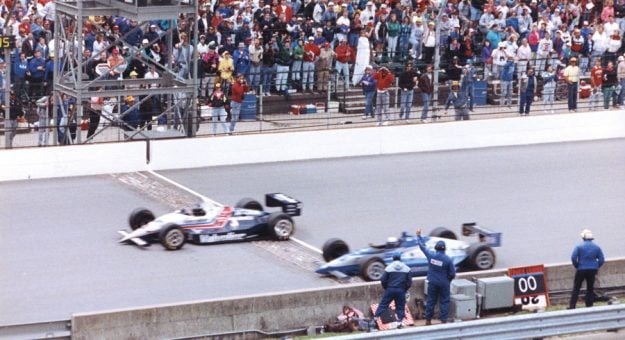CONCORD, N.C. — Thirty years ago this month, the average national price for a gallon of gas was $1.13, George H.W. Bush was in the White House and Duke had just won the men’s NCAA basketball championship for the second time in as many years.
It was also the year in which the closest Indianapolis 500 finish occurred, when Al Unser Jr. topped Scott Goodyear by a miniscule .043 seconds.
Or did he?
There’s no doubt that Little Al won the race, becoming the first second-generation driver to win the prestigious event and adding the eighth victory for the Unser family (which he would boost to nine just two years later).
What is at issue is the margin of victory because it was later amended to be even closer after review because of the difference in where the transponders were on Unser Jr.’s car and that of Goodyear.
Unser Jr.’s transponder was in the nose of his Galmer chassis, while Goodyear’s Lola sported its transponder in the left sidepod. After review, Mike Devin recalculated the MOV to .031 seconds.
While the original .043-second advantage still stands as the official margin of victory, it is interesting that it was updated with so little fanfare.
The story of that race is well-known. It was cold and wet on race day, with temperatures in the 40s and a strong wind made it seem even colder. That would be a harbinger of what was to come, as polesitter Roberto Guerrero lost control on the pace lap and crashed out of the race.
It would be a theme for the day.
Michael Andretti led 160 of the first 189 laps before the fuel pump on his car quit, leaving him without power in the short chute between turns three and four with 11 laps remaining. Prior to that, only 15 cars remained on the track and just five were on the lead lap.
Unser Jr., driving a team-built Galmer chassis with a first-gen Chevrolet engine for car owner Rick Galles, inherited the lead with just seven laps remaining. Goodyear, the fast Canadian driver who had started 33rd on the day, was second.
What followed was a gripping conclusion to a dark and windy day.
Unser Jr. held Goodyear at bay over those remaining laps through determination and savvy moves. With two laps to go, Little Al led by three-tenths of a second but Goodyear was waiting for a chance. He got it into turn three and pulled up on the rear wing of Unser. Off turn four, Unser got loose, tightening the margin even more.
At the white flag, the leaders were under a blanket, and through the next three corners, Goodyear was right there on Unser Jr.’s tail. Coming off turn four, Unser began changing his line, forcing Goodyear to go low. Ultimately, he crossed under the double checkered flags with .043 seconds (initially) to spare.
Watching from the old open-air press box on the grandstand side of the track, it was as thrilling a duel as I had ever seen, and I was there 10 years earlier in 1982 when Gordon Johncock held off Rick Mears in a similar finish. Ironically, that .16-second margin of victory 10 years prior was the closest in 500 history before Unser Jr. and Goodyear uncorked their classic duel.
The 1992 race was significant in another way, too. The race marked the final 500 starts for A.J. Foyt, Mears, Tom Sneva and Johncock. Among them, the four drivers had won the Indy 500 a combined 11 times (Foyt and Mears 4 each, Johncock 2 and Sneva 1).
The weather took a toll too, as 13 drivers crashed out of the race and 13 cautions ate up 85 of the 200 laps.
It was a day to remember — and to forget — for the huge crowd of fans and the drivers involved. Will we enjoy another one like it? Maybe 2022 will see a return to the trend of close finishes at Indianapolis.
